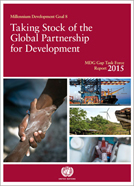
The Millennium Development Goals (MDGs) achieved significant progress over the past 15 years, but persistent gaps in official development assistance and an insufficient access to markets, affordable medicines and new technologies have highlighted the need for a rejuvenation of the global partnership for development, according to a new report launched today by United Nations Secretary-General Ban Ki-moon.
The “Taking Stock of the Global Partnership for Development” report of the United Nations MDG Gap Task Force monitors the recent achievements and challenges in the implementation of the Millennium Development Goal 8, while looking ahead towards the new sustainable development agenda that will be adopted by world leaders at the Sustainable Development Summit this month (25-27 September), and which will include the launch of a new set of Sustainable Development Goals.
“Transitioning from the Millennium Development Goals to the Sustainable Development Goals presents a once-in-a-generation opportunity to advance prosperity, secure the planet’s sustainability for future generations”, said Secretary-General Ban Ki-moon in the preface to the report.
“Achieving the SDGs will require an even stronger global partnership, complemented by multi stakeholder partnerships to mobilize and share knowledge, expertise, technology and financial resources”.
Key report findings reveal official development assistance flows have increased remarkably by 66 per cent from 2000 to 2014. In merchandise exports, developing countries’ access to developed-country markets has improved from 30.5 to 43.8 per cent over the same period.
Debt burdens have been reduced in most highly indebted poor countries. Mobile phone penetration in developing countries is estimated to reach 92 per cent at the end of 2015, compared to less than 10 per cent in 2000.
Nevertheless, the Report also finds that major gaps persist in development aid flows to the least developed countries and in eliminating trade barriers for developing countries. Additionally, many people cannot access essential medicines and the Internet at affordable prices.
Market access for developing countries expanded
Developing countries received duty-free treatment on only 65 per cent of their exports to developed countries in 2000, but on 79 per cent in 2014 (excluding arms). Duty-free imports from least developed countries increased from 70 per cent to 84 per cent of their trade over the same period. South-South trade has become an important source of trade expansion.
But, the merchandise exports of least developed countries accounted for only 1.17 per cent of world trade in 2013. According to the Report, there is the need for developed countries to eliminate more barriers to trade, while the remaining Doha Round issues need to be tackled.
Debt relief progressed in 36 out of 39 eligible countries
Debt relief has reduced financial pressures in 36 out of 39 highly indebted poor countries, and only three countries Eritrea, Somalia and Sudan—have yet to start the debt-relief process. The overall ratio of external debt to gross domestic product (GDP) of developing countries has declined over the past decade, but it has been increasing in some countries in recent years.
However, a number of developing countries, particularly small States, continue to face some of the highest debt-to-GDP ratios in the world, and their underlying economic problems warrant further attention. An urgent need remains for the international community to assist countries to enhance their policies towards debt-crisis prevention and to facilitate resolution of crises.
Access to affordable essential medicines still limited
The availability of essential medicines is still low in developing countries. According to the data on medicine availability and prices, collected in 26 surveys from 2007 to 2014 in a sample of low- and middle-income countries, generic medicines were available on average in 58.1 per cent of public sector facilities and in 66.6 per cent of private sector facilities.
Nevertheless, there have been efforts to increase treatment access, in particular for some diseases such as HIV, tuberculosis and malaria, largely owing to a massive influx of national and international funding, such as from the Global Fund.
Mobile phone signals reach 95 per cent of the world’s population
The Task Force estimates that the number of mobile-cellular subscriptions in the world is estimated to grow to just over 7 billion by the end-2015 and more than 95 per cent of the world’s population will be covered by a mobile-cellular signal. Forty-three per cent of the world’s population uses the Internet today.
The growth of Internet users is robust in developing countries, but only 32 per 100 inhabitants are estimated to be using the Internet, as compared with 80 per cent of people in developed countries in 2014. Access to information and communication technologies (ICTs) can be an important enabler of broader development objectives such as “e-governance” services so that greater efforts must be undertaken, especially in the economies that most need ICTs but which are least able to access them.
Background
The United Nations MDG Gap Task Force is an inter-agency initiative that includes more than 30 organizations with specialised competence in the five core domains of the global partnership for development: official development assistance (ODA), market access (trade), debt sustainability, access to affordable essential medicines and access to new technologies.
